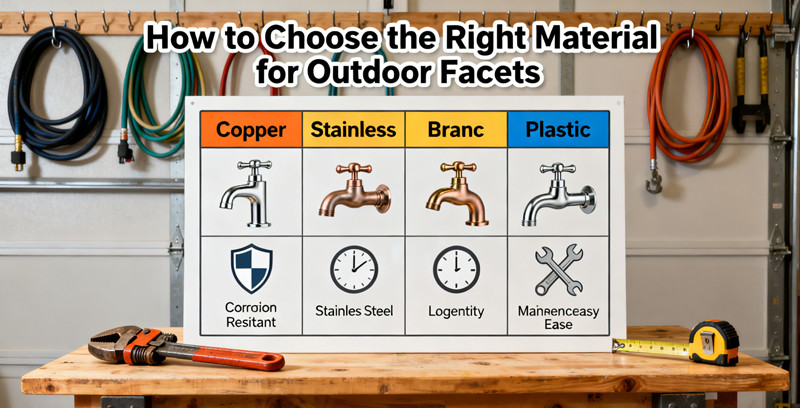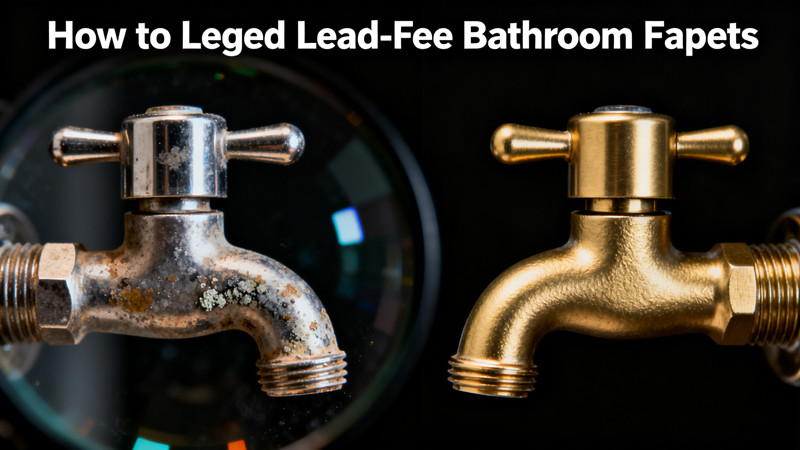Outdoor faucets may seem like simple fixtures, but they face some of the harshest conditions of any plumbing component in your home. From blazing summer sun to freezing winter nights, outdoor faucets must endure constant exposure to the elements while still providing reliable water flow year after year. One of the most important factors that determine how long an outdoor faucet lasts—and how well it performs—is its material.
Choosing the right faucet material not only affects durability and maintenance but also helps you avoid leaks, corrosion, and costly replacements. In this guide, we’ll break down the most common faucet materials, their pros and cons, and how to choose the best one for your outdoor setup.
Why Faucet Material Matters
Outdoor faucets experience much more environmental stress than indoor ones. They’re exposed to moisture, dirt, and extreme temperature changes that can cause corrosion, rust, and cracking. The wrong material can quickly deteriorate, leading to leaks, water waste, and property damage.
By contrast, the right material ensures:
-
Corrosion resistance against rain, minerals, and air.
-
Freeze resistance in cold climates.
-
Longevity, reducing maintenance and replacement costs.
-
Consistent performance, even with high or fluctuating water pressure.
Whether you’re installing a garden hose bib, a wall-mounted spigot, or a decorative outdoor faucet, material selection plays a key role in both function and lifespan.
Common Materials for Outdoor Faucets
Let’s take a closer look at the most popular materials used for outdoor faucets and what makes each one unique.
1. Brass
Brass is one of the most traditional and reliable materials for outdoor faucets—and for good reason. A brass faucet typically contains a mix of copper and zinc, which gives it a distinctive gold tone and exceptional corrosion resistance.
Pros:
-
Highly durable: Brass resists cracking, corrosion, and mineral buildup.
-
Excellent longevity: Can last for decades even in harsh environments.
-
Easy to repair: Brass parts are widely available and easy to replace.
-
Freeze-resistant: Can withstand temperature swings without breaking.
Cons:
-
Higher cost: Brass faucets are generally more expensive than zinc or plastic.
-
Lead content: Always look for lead-free brass, especially for drinking water sources.
Best for: Homeowners seeking long-term performance and minimal maintenance. Ideal for hose bibs and high-use outdoor faucets.
2. Stainless Steel
Stainless steel is another excellent choice, especially for homeowners who value both durability and modern aesthetics. Unlike brass, stainless steel resists tarnishing and maintains a sleek finish for years.
Pros:
-
Corrosion-resistant: Excellent protection against rust, even in coastal areas.
-
Modern appearance: Retains its shine and finish longer than most materials.
-
Hygienic: Doesn’t leach metals into the water.
-
Strong and lightweight: Ideal for frequent use and high water pressure.
Cons:
-
More expensive: Typically costs more than brass or zinc.
-
Grades matter: Not all stainless steel is equal—304 stainless steel or higher is best for outdoor use.
Best for: Homes in humid or coastal regions, or anyone wanting a long-lasting, rust-resistant faucet with a sleek look.
3. Zinc Alloy
Zinc alloy faucets are an economical option and often used in budget-friendly outdoor fixtures. While they can look similar to brass or steel at first glance, they’re generally less durable over time.
Pros:
-
Affordable: Great for those on a tight budget.
-
Lightweight: Easy to handle and install.
-
Good corrosion resistance: Works well in mild climates.
Cons:
-
Shorter lifespan: Prone to corrosion and cracking after prolonged exposure.
-
Weaker under stress: May not hold up well in freezing conditions.
-
Not ideal for frequent use.
Best for: Occasional outdoor use or mild climates where weather exposure is minimal.
4. Plastic (PVC or ABS)
Plastic outdoor faucets, often made from PVC or ABS, are lightweight and inexpensive. They’re primarily used in temporary or low-pressure setups such as garden irrigation systems.
Pros:
-
Resistant to rust and corrosion.
-
Affordable and easy to replace.
-
Ideal for low-pressure applications.
Cons:
-
Low durability: Can crack under pressure or in cold weather.
-
Limited lifespan: May degrade under UV exposure.
-
Not suitable for heavy-duty use.
Best for: Temporary outdoor water lines, drip irrigation, or areas with mild weather.
5. Bronze
Bronze faucets are a premium choice, offering both style and strength. They are often used for decorative outdoor faucets or in high-end garden designs.
Pros:
-
Extremely durable: Resists corrosion and wears beautifully over time.
-
Aesthetic appeal: Adds a rustic or vintage touch.
-
Performs well in tough climates.
Cons:
-
High cost: Among the most expensive materials.
-
Color changes: May develop a patina with age (some see this as a benefit).
Best for: Luxury outdoor spaces or decorative setups that value beauty and longevity.
Choosing the Right Faucet Material for Your Climate
Your local climate plays a major role in material selection.
-
Cold regions: Choose brass or stainless steel for their freeze resistance. Consider frost-proof faucet models to prevent cracking.
-
Coastal areas: Go with 304 or 316 stainless steel, which resists saltwater corrosion.
-
Hot and dry climates: Brass performs well without warping or cracking in the heat.
-
Mild climates: Zinc or plastic faucets can be a cost-effective choice with proper care.
Tips for Maximizing Faucet Lifespan
No matter which material you choose, a few maintenance steps can help extend your faucet’s life:
-
Install a frost-proof faucet in cold climates to prevent freezing damage.
-
Shut off the water supply to outdoor faucets during winter months.
-
Drain and disconnect hoses before freezing temperatures arrive.
-
Clean mineral deposits periodically to maintain flow efficiency.
-
Inspect seals and washers annually to prevent leaks.
Regular maintenance ensures your faucet stays in good shape, reducing the need for replacements and avoiding costly water waste.
Final Thoughts
Choosing the right material for your outdoor faucet is about balancing durability, cost, and climate compatibility. Brass remains the most time-tested and reliable choice, while stainless steel offers a modern, rust-resistant alternative. Zinc and plastic serve well for budget-friendly or light-duty needs, and bronze is perfect for homeowners seeking both beauty and resilience.
By understanding the strengths and weaknesses of each material—and matching them to your local conditions—you’ll ensure your outdoor faucet performs flawlessly for years to come. After all, the right faucet isn’t just about water flow—it’s about peace of mind and long-term value for your home.








